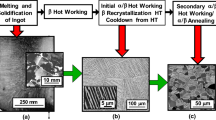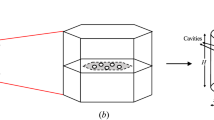Abstract
A multi-scale, mechanistic model is developed to describe and predict the dwell-fatigue crack growth rate in the P/M disk superalloy, ME3, as a function of creep–environment interactions. In this model, the time-dependent cracking mechanisms involve grain boundary sliding and dynamic embrittlement, which are identified by the grain boundary activation energy, as well as, the slip/grain boundary interactions in both air and vacuum. Modeling of the damage events is achieved by adapting a cohesive zone (CZ) approach which considers the deformation behavior of the grain boundary element at the crack tip. The deformation response of this element is controlled by the surrounding continuum in both far field (internal state variable model) and near field (crystal plasticity model) regions and the intrinsic grain boundary viscosity which defines the mobility of the element by scaling up the motion of dislocations into a mesoscopic scale. This intergranular cracking process is characterized by the rate at which the grain boundary sliding reaches a critical displacement. A damage criterion is introduced by considering the grain boundary mobility limit in the tangential direction leading to strain incompatibility and failure. Results of simulated intergranular crack growth rate using the CZ model are generated for temperatures ranging from 923 K to 1073 K (650 °C to 800 °C), in both air and vacuum. These results are compared with those experimentally obtained and analysis of the model sensitivity to loading conditions, particularly temperature and oxygen partial pressure, are presented.















Similar content being viewed by others
References
H. Ghonem, T. Nicholas and A. Pineau: Fatigue Fract. Eng. Mater. Struct., 1993, vol. 5, pp. 565–76.
H. Ghonem, T. Nicholas and A. Pineau: Fatigue Fract. Eng. Mater. Struct., 1993, vol. 16, pp. 577–90.
H. Ghonem and D. Zheng: Metall. Trans. A, 1992, vol. 23A, pp. 3067–72.
D.G. Leo Prakash, M.J. Walsh, D. Maclachlan and A.M. Korsunsky (2009) Int. J. Fatigue 31: 1966–77.
Y.L. Lu, L.J. Chen, P.K. Liaw, G.Y. Wang, C.R. Brooks, S.A. Thompson, J.W. Blust, P.F. Browning, A.K. Bhattacharya, J.M. Aurrecoechea and D.L. Klarstrom: Mater. Sci. Eng. A, 2006, vol. 429, pp. 1–10.
S.P. Lynch, T.C. Radtke, B.J. Wicks and R.T. Byrnes: Fatigue Fract. Eng. Mater. Struct., 1994, vol. 17, pp. 297–311.
S. Dalby and J. Tong: J. Mater. Sci., 2005, vol. 40, pp. 1217–28.
H. Yang, R. Bao, J. Zhang, L. Peng and B. Fei: Eng. Fail. Anal., 2011, vol. 18, pp. 1058–66.
R.P. Wei and Z. Huang: Mater. Sci. Eng. A, 2002, vol. 336, pp. 209–14.
A.C.F. Cocks and M.F. Ashby: Prog. Mater. Sci., 1982, vol. 27, pp. 189–244.
G.L. Dunlop and J.O. Nilsson: Mater. Sci. Eng., 1980, vol. 42, pp. 273–80.
C. Gandhi: in Flow and Fracture at Elevated Temperatures, R. Raj, ed., American Society for Metals, Materials Park, OH, 1985, pp. 83–119.
A. Pineau: in Flow and Fracture at Elevated Temperatures, R. Raj, ed., American Society for Metals, Materials Park, OH, 1985, pp. 317–47.
R. Raj: in Flow and Fracture at Elevated Temperatures, R. Raj, ed., American Society for Metals, Materials Park, OH, 1985, pp. 215–49.
K. Shiozawa and J.R. Weertman: Acta Metall., 1983, vol. 31, pp. 993–1004.
A. Needleman and J.R. Rice: Acta Metall., 1980, vol. 28, pp. 1315–32.
W.D. Nix and J.C. Gibeling: in Flow and Fracture at Elevated Temperatures, R. Raj, ed., American Society for Metals, Materials Park, OH, 1985, pp. 1–63.
J. Dahal: Master’s Thesis, University of Rhode Island, 2011.
J. Dahal, K. Maciejewski and H. Ghonem: Int. J. Fatigue, 2013, vol. 57, pp. 93–102.
A.D. Sheikh-Ali: Scripta Metall. Mater., 1995, vol. 33, pp. 795–801.
H. Yoshida, K. Yokoyama, N.Shibata, Y. Ikuhara and T. Sakuma: Acta Metall., 2004, vol. 52, pp. 2349–57.
G.R. Kegg, C.A.P. Horton and J.M. Silcock: Philos. Mag., 1973, vol. 27, pp. 1041–55.
R.Z. Valiev, V.G. Khairullin and A.D. Sheikh-Ali: Russ. Physics J., 1991, vol. 34, pp. 253–61.
K. Reading and D. Smith: Philos. Mag. A, 1985, vol. 51, pp. 71–78.
A. Pineau and S.D. Antolovich: Eng. Fail. Anal., 2009, vol. 16, pp. 2668–97.
E. Andrieu, R. Molins, H. Ghonem and A. Pineau: Mater. Sci. Eng. A, 1992, vol. 154, pp. 21–28.
S. Kirchhoff: Master’s Thesis, University of Rhode Island, 2008.
U. Krupp, W. Kane, J. Pfaendtner, X. Liu, C. Laird and C. McMahon Jr.: Mater. Research, 2004, vol. 7, pp. 35–41.
R.W. Hayes: Metall. Mater. Trans. A, 2008, vol. 39A, pp. 2596–2606.
U. Krupp, W.M. Kane, C. Laird and C.J. McMahon: Mater. Sci. Eng. A, 2004, vol. 387, pp. 409–13.
D. Bika and C.J. McMahon Jr.: Acta Materialia, 1995, vol. 43, pp. 1909–16.
W.Z. Zhuang and N.S. Swansson: Thermo-Mechanical Fatigue Life Prediction: A Critical Review, Submitted to Airframes and Engines Division, Aeronautical and Maritime Research Division, internet source: DSTO-TR-0609.
C.M. Branco, A.S. Brito, and J. Byrne: Life Extension Methodology Based on Creep-Fatigue Models, Presented at the RTOAVT Workshop on Qualification of Life Extension Schemes for Engine Components, Corfu, Greece, October 1998.
Y. Sun, K. Maciejewski and H. Ghonem: Int. J. Damage Mechanics, 2013, vol. 22, pp. 905–23.
O. Nguyen, E.A. Repetto and M. Ortiz: Int. J. Fracture, 2001, vol. 110, pp. 351–69.
K.L. Roe, T. Siegmund: Eng. Fracture Mech., 2003, vol. 70, pp. 209–32.
F.L. Carranza and R.B. Haber: J. Mech. Physics Solids, 1999, vol. 47, pp. 27–58.
J. Dahal, K. Maciejewski, and H. Ghonem: in Grain Boundary Deformation and Damage Mechanisms in Dwell Fatigue Crack Growth in Turbine Disk Superalloy ME3, Superalloys 2012, Seven Springs Mountain Resort, Champion, Pennsylvania, September 9–13, 2012, E.S. Huron, R.C. Reed, M.C. Hardy, M.J. Mills, R.E. Montero, P.D. Portella, and J. Telesman, eds., The Minerals, Metals and Materials Society, Warrendale, PA, 2012, pp. 149–58.
J. Li: MRS Bulletin, 2007, vol. 32, pp. 151–59.
M.M. Hall Jr.: Proceedings of the International Symposium on Plant Aging and Life Prediction of Corrodible Structures, Sapporo, Japan, May, 1995, Paper A-I-09.
M.J. Starink and P.A.S. Reed (2008) Mater. Sci. Eng. A 491: 279–89.
G. Venkataraman, Y.W. Chung and T. Mura: Acta Metall., 1991, vol. 39, pp. 2621–29.
K. Maciejewski: PhD Thesis, University of Rhode Island, 2013.
F.W. Crossman and M.F. Ashby: Acta Metall., 1975, vol. 23, pp. 425–40.
T. Kê: Phys. Rev., 1947, vol. 71, pp. 533–46.
F. Cosandey: J. De Phys., 1988, vol. C5, pp. 581–86.
E. Arzt, M.F. Ashby and R.A. Verrall: Acta Metall., 1983, vol. 31, pp. 1977–89.
H.J. Frost and M.F. Ashby: Deformation Mechanism Maps: the Plasticity and Creep of Metals and Ceramics, Pergamon Press, Oxford, U.K., 1982.
Abaqus Version 6.8, Dassault Systèmes Simulia Corp, Providence, RI, 2008.
M. Gell and G.R. Leverent: Fatigue at Elevated Temperature, 1973, pp. 37–66.
D. Kuhlmaan-Wilsdorf: in Low-Energy Dislocation Structures II, 2nd International Conference on Low Energy Dislocation Structures, M.N. Bassim, W.A. Jesser, D. Kuhlmann-Wilsdorf, and G.J. Shiflet, eds., Materials Science and Engineering, 1989, pp. 1–41.
Acknowledgments
The authors acknowledge the support from the MAI (Metals Affordability Initiative) Program FA8650-08-2-5247, in collaboration with the Air Force Research Lab, Pratt & Whitney, GE Aviation, Georgia Institute of Technology and Ohio State University.
Author information
Authors and Affiliations
Corresponding author
Additional information
Manuscript submitted May 7, 2013.
Rights and permissions
About this article
Cite this article
Maciejewski, K., Dahal, J., Sun, Y. et al. Creep–Environment Interactions in Dwell-Fatigue Crack Growth of Nickel Based Superalloys. Metall Mater Trans A 45, 2508–2521 (2014). https://doi.org/10.1007/s11661-014-2199-z
Published:
Issue Date:
DOI: https://doi.org/10.1007/s11661-014-2199-z




